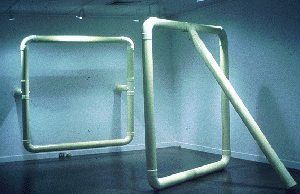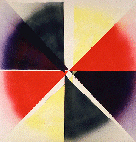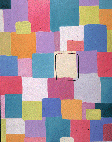Over It Fiona Macdonald
|
 Gary Wilson, Floor
piece, wall piece, |
Over It Fiona Macdonald
|
 Gary Wilson, Floor
piece, wall piece, |
| What is non-objective space? Can it be anything other than what is oive or is it limited by its relationship with its opposite? Is it constituted around the singularity of that which it is not or is it multiple or various? Is it something defined by a negation. That is, the space of a dialectic? | In the catalogue from a 1993
show of recent abstraction I read the term
"non-objective space", speaking it seems of the
subject through negation and describing both as a kind of
free-floating subjective, planar experience and an
historical given. I realise I do not have that given. Malevich wrote that non-objective art has "deliberately given up objective representation ... in order to reach the summit of the true 'unmasked' art and from this vantage point to view life through the prism of pure artistic feeling". The texts of non-objectivism, written simultaneously with the production of the art to distinguish the art and the artists as aggressively avant-garde, provide a construction of the avant-garde that adhered to the guidelines of art history. These texts are the voice of the still constructed subject - the accelerated pathology of the Suprematist subject "who does not observe and does not touch. He feels. The promise of this new art was to produce "new forms and form relationships by giving external expression to pictorial feeling".1 These relationships of form were extended off the canvas into architecture and into "space". They constituted a rush into the non-objective autonomous future of pure feeling. |
| The Australian movement of non-objectivist abstraction which was activated in the late 1980s as an alternative to what was perceived to be the constraints and surfeits of postmodern art and post-structuralist theory, organised itself through the structures of this model.2 These artists from Sydney and Melbourne came together forming groups and defining themselves through their own exhibition spaces, group shows and texts. They were concerned with the rehabilitation of an aesthetic based on experimental values and geared their own practices on modernist abstraction. More specifically they relied on the formal logic of geometric abstraction and the shift of art into daily life reflected in non-objectivism and Constructivism. | |
 Kerrie Poliness, Untitled painting, enamel on canvas, 1989-92 Also see Wall Drawings |
Investigating the formal properties of the geometric through perceptual or material extensions, these projects were seen as part of a larger, ongoing and experimental project and revolved around a performative affirmation of the creative and material action of making art. Signature materials and forms were developed (cross, circle, grid, diamond, cardboard, oil, spray, enamel, plastic, felt, painting, assemblage, etc.) and these specificities of manufacture or geometry made up both a generic signature and an individual and new signature, even a new gestalt. The artworks themselves were produced with a seeming lack of hierarchy that reintroduces the field into the late twentieth century, working as a strategy of actuating the surface qualities of the work. This pointing back to the inside of the frame is a concept that belongs to pure plasticism and marks a return to that system of values and its associations with the primacy of painting. |
| To invoke the project of avant-garde abstraction is necessarily pre-written and perhaps that is its charisma. It is to invoke abstraction's promise of pure form with its transcendent detachment from other, necessarily historical genres and its trans-historical exteriority as a law-form. It is a contract. These contemporary projects are task-oriented and geared to an anabolic, quantitative process: of activities as artist, of various totalities of art production, an incremental layering of product and artist, of principle and reiteration. These are manufactured through a mechanistic concept of labour that is an extension of the industrial aesthetic of the subjectivities of earlier abstraction. This romance of the denatured body and the productive labour of surfaces is the starting point of the law-form from where there is an accumulative path to an iconic principle (of the Symbolic) and a reductive course to its furtherest consequences (in the repetition of formalist extensions). Repetition is a binding process even with oneself. | |
| The historical avant-garde believed that past art was meaningful only after it had been displaced, when its pure aesthetic structure was able to be discerned and sanctified within the museum. This constituting rupture is an exegesis of the avant-garde and frames a convention of rupture, displacement and the historical future. Each return of the avant-garde, structured as it is in an rhetorical relation to the institution (part of the convention of the self-referential work of art where in order to be a work of art it must be seen to be a work of art), shows this convention as a site configured by conflations, such as the tragic-heroic of the avant-garde and its subsequent appearances as trope. | |
| A propos pictorial space, Greenberg wrote, it is "an entity belonging to the same order of space as our bodies; it is no longer the vehicle of the imagined equivalent of that order. Pictorial space has lost its 'inside' and become all 'outside'". Art and Culture, 1961 | To reinvigorate this residual subject, whether as positive space of negative effect or as bound to a trajectory from the conforming centre is to be present only as effect. Its like being a footnote to nihilistic modernity. This is the basis of the psychosis articulated in the order of space developed by Greenberg; its where the inside becomes all outside, the cosmic cum painting, a snowstorm of pure projection. This screen, equivalent to but not the body, is a field of transference where the figure/ground dialectic with its genesis of original failure,3 is a thing whose positive form is an embodiment of Nothing. This catastrophic object oscillating between banality and over-determination is the same sublime that can encompass the scoptophilia of any number of formalist returns and the exmaination of its effects. It merely foregrounds its effects through an aesthetic of scatology and detritus. |
| These antagonisms of the
sublime are old arguments. They are so démodé
that they are reconstituting themselves through a
dialectical logic of fashion that allows for a new
rhetorical return of the same. It is the reflexive limit
of the transcendent master narrative. For capitalism and
modernism it is the impotence of the limit that engenders
the teleology of development (and survival) - it produces
the paradox that defines surplus-enjoyment and the
material leftover of the vacancy waiting to be filled. This contemporary return would demur from its relationship with theory. This is a kind of reverse paradox in that its existence depends on it. However, this return is not that of memory, for there is no memory in this contemporary context. Only the passage of imported universals and a global unconscious. It is the lack or absence of memory that provides a suspended space for an overwriting of fantasy onto the Symbolic - a new sublimation and the creation of a phantasm. It is also in this phantasmic mirror space of the historical that "Modern Revival"4 figures itself as both history-subject and history-painter. |
|
| A propos the ego, Freud wrote, "it is not merely a surface entity, but is itself the projection of a surface". 1923 | The academy, such as the one that modernism first liberated itself from in the 1860's, was formed around a contract of an already established model of achievement comprising a school and a formalism and organised its art production around this institutional contract. This process involved the representing of a subjective viewpoint through historical subject by its reframing through a moral and ethical taxonomy of pictorial and material signifiers. It was at this surface level that signification of the work was appended which took the form of a series of equations linking surface qualities and moral values - a trans-substantiation of moral embodiment and surface finish that created a kind of vibration of ethos. |
| This same surface signification operates in one of the contractual subtexts of masochism. In masochism, the delay brought about by the physical and temporal suspension of effect is created through a re-framing onto signifying surfaces and the forming of an eternalised space (the illusio) of a disavowal where the real and the ideal are absorbed. It is the mirror space of a self-relationship taking place on the surface where this self that is no more than the surface, can reincorporate both its transgression and transcendence. In a word, narcissism. It is a recuperation of sensualism aimed at removing the Father/Law/ Symbolic by holding them in an eternal suspension outside the reflection of the dialectic. | |
| A propos the square, Malevich wrote, "it is worth the effort to try to find out what it contains. Nobody has really given it a thought." Letter to Ettinger, 3 April, 1920 | One of the primary concerns
of the "ists" is the distressed, crappy quality
of the original artworks of historical modernism.
Presumably this can be construed as the failure of
reputation, a quality that has been reified into a kind
of aggregating ethical patina. Whether it is the pose of
aesthetic indifference of the avant-garde, the failure of
the success of Constructivism, the successful failure of
formalism, all these possess this aggregated surface
quality. This surface disposition is the signifier for
these artists and has been reenacted through materials
and manufacture or as a formula to overlay the same auras
into the contemporary artworks. This moral and erotic surface has been particularised in the use of low-art materiality. The gesture is a kind of slovenly adoration of the seeming transgression of tart or tack . Its a mimicry intact but in reduced circumstances or with reduced history, a transvestism of the exterior of the kitchen cupboard or the interior of a suburban wardrobe. It is the haberdashery effect of the reduction of the law-form taken to its furtherest consequences - overwriting the icon with the fetish, not through the substitution of an alternative law (degradation and embellishment are part of the canon after all), but by eroticising the existing law through a compulsion with signifying surfaces. A form of hommage perhaps. This cult of style as the thing in itself not only brings about a pure realm of clarified production (and its spiritual signifieds), but by this giving over of the utmost significance to style it possesses the erotic charge of any adherence to subjective states and surface qualities. |
 Rose
Nolan, Not sensitive with standards, |
This revival has also been
distinguished by its defective drawing and inexact
geometries; its bad painting, its imperfect and
incompetent delineating of figure and ground, the
wobbly-leaky lines and infantile manufacture. These are
points of noted fascination, authorship and aura. The
recent commentaries on the work have attributed this as
both formal device and an intervention - a new aesthetic
of "badness" or commonness that isn't kitsch
(although it possesses similar characteristics in its
banality and intrusiveness) but rather a kind of autistic
bodily intervention, "a mucking around", which
happens in the work at the process stage and is left to
interface with the perceptual surface plane.5 This revivel nominates its
inspiration as the 'failures' of modernism. Whether this
is the failed political and cultural project of the
avant-garde, or their own repeating the first failure in
a reversal of the contract of the paradigm, or simply the
Burgeresque historiography of failed stylism that
accessorise a formalist return. With its conception of `first mark' as debaser of the pure field of the canvas, formalism had already signalled the abject place of the subject. These construction of badness or bad practice characterise the stain of the failed subject leaking into the field as a breakthrough or a breakdown, as a diacrisis of the hysterical - "I will use bad artistic practice and I will mark my self as present through imperfection and insignificance and I will do this in the perceptual, at the interface of the dialectic of abstraction (where everybody can see)" - which detaches the symbolic and reconstitutes itself as subject in the perceptual. It could be said that the dialectic of abstraction is being replaced with a dialectic of reversal, disguise and reduplication and that beyond the repetition that links is the repetition that erases or destroys. This would be the transgressive position of the avant-garde and one linked to the cycles of surplus-value and surplus-enjoyment that might appear to be manifest in this work. But this transgressive position has all the resonance of an Oprah show consenus - why not enjoy it! or, you can do it too! (why one would want to is maybe more to the point). Perhaps what appears as transgression is more a manifestation of the abjected position of both subject and work in its rhetorical relation to the institution - a fin-de-siecle objection of the over-receptive and over-stimulated, denatured and internationalised (again) subject . |
 Angela Brennan, If and only if, |
Repetition announces the
advent of the Law not only through a formalising of
structure but also of effects. The effect that this art
has produced has been the re-establishing of the
coincidence of art and aesthetics and attendant to this
the reappearance of the language of the modernist canon,
with its aesthetics, hierarchies, denominations, etc., to
furnish a re-evaluation regarding the physical and
material acts of production, the structuring of artistic
identity and the reactivated position of the avant-garde
with its interchangeable signifiers of art and artist and
its nexus of transcendence and transgression. It is a
revisionism that draws on the discrete disciplines of
19th century empiricism and their evolutionary and
formalist discourses. It is significant that the lexicon of art criticism can only describe this abjected subject by what it is or is not in relation to its Paternity. This may hold a certain frisson for the institution but perhaps it is this negation that gives this art its childlikeness and insouciance, its disavowals and autism, its narcissism and cutisms, its de-sexuality, like being perpetually stuck in the mirror phase of the constitutive avant-garde. It amounts to a diminishing regress to Degree Zero. |
| Fiona Macdonald 1996 Endnotes |